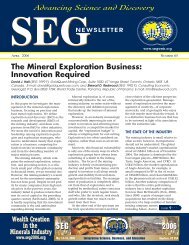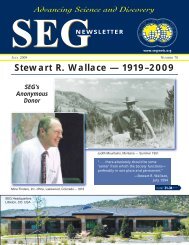SEG 45 Final_qx4 - Society of Economic Geologists
SEG 45 Final_qx4 - Society of Economic Geologists
SEG 45 Final_qx4 - Society of Economic Geologists
You also want an ePaper? Increase the reach of your titles
YUMPU automatically turns print PDFs into web optimized ePapers that Google loves.
10 <strong>SEG</strong> NEWSLETTER No 63 • OCTOBER 2005<br />
... from 9<br />
Exploring for Deposits Under Deep Cover Using Geochemistry (Continued)<br />
the strong anomalies for Zn and Cd<br />
were enigmatic. Why would these elements<br />
be strongly anomalous over an<br />
Au-Cu deposit? Further drilling by<br />
Newmont described by Norby and<br />
Orobona (2002) revealed the presence <strong>of</strong><br />
a deposit-wide blanket <strong>of</strong> sphalerite concentrated<br />
in the upper 60 m <strong>of</strong> the sulfide<br />
zone, approximately 500 m below<br />
surface. The secondary Zn blanket, containing<br />
1 to 4% Zn, contains submicrometer-sized<br />
framboids <strong>of</strong> sphalerite<br />
that have extremely low values for δ 34 S,<br />
down to –70‰, indicative <strong>of</strong> bacterial<br />
reduction <strong>of</strong> sulfate during supergene<br />
alteration (Bawden et al., 2003).<br />
Cadmium is a ubiquitous constituent <strong>of</strong><br />
sphalerite, with contents typically in the<br />
range 0.1 to 0.8% (Piatak et al., 2004).<br />
Newmont is currently measuring the Cd<br />
content <strong>of</strong> the sphalerite-rich zone.<br />
Preliminary results give average Cd/Zn<br />
ratios above that obtained from crustal<br />
abundance data for these elements.<br />
Norby and Orobona (2002) provide<br />
additional structural detail for the<br />
deposit. The interpreted post-Carlin<br />
Formation fault B, where the strongest<br />
geochemical anomalies are found at the<br />
surface, corresponds to the Nebulous<br />
fracture zone, which forms the boundary<br />
structure for the West Mike secondary<br />
mineralization, including the Zn-rich<br />
zone (John Norby, pers. commun., 2003).<br />
Its location in the basement was recognized<br />
by gravity contrast caused by <strong>of</strong>fsets<br />
along the basement unconformity.<br />
This fault has a westerly dip (Norby and<br />
Orobona, 2002), and thus the surface<br />
trace (fault B) shown by the topographic<br />
relief is east <strong>of</strong> the gravity expression in<br />
the basement (Figure 1a). Similarly, fault<br />
C is the surface expression <strong>of</strong> the westerly<br />
dipping North-Pointing Dog fault <strong>of</strong><br />
Norby and Orobona (2002). Fault A may<br />
be the surface topographic expression <strong>of</strong><br />
a westerly dipping D-Day fault or a<br />
down-faulted block between the<br />
D-Day and Hillside faults. North-northeast–striking<br />
faults, such as the<br />
Nebulous, locally control gold mineralization<br />
and also down-drop mineralization<br />
and the base <strong>of</strong> oxidation. There are<br />
landslides along the southwest projections<br />
<strong>of</strong> the Nebulous and D-Day faults<br />
(John Norby, pers. commun., 2003),<br />
which may reflect recent earthquakes.<br />
We interpret the anomalies at the<br />
surface intersection <strong>of</strong> the Nebulous<br />
fracture zone to be the result <strong>of</strong> mobilization<br />
<strong>of</strong> metals where the permeable<br />
fault zone cuts the ores, and pumping<br />
<strong>of</strong> the resulting metalliferous fluids up<br />
the fault. It is likely that it was the constituents<br />
<strong>of</strong> the sulfide zone that were<br />
the most amenable to oxidation and<br />
mobilization. In addition to Au, Cu, Cd,<br />
and Zn, other elements such as Ag, As,<br />
Ba, Hg, Mo, Ni, Sb, Se, and V are<br />
anomalous along the surface intersection<br />
<strong>of</strong> the Nebulous fault. Major elements<br />
such as K and Na, which might<br />
indicate hydrothermal alteration, are<br />
not enhanced. Isotopic studies by<br />
Dublyansky et al. (2003) at the Yucca<br />
Mountain nuclear waste disposal site,<br />
also in Nevada, have shown that fluids<br />
<strong>of</strong> deep-seated origin have moved up<br />
several hundred meters along a permeable<br />
fault through a thick vadose zone.<br />
SPENCE DEPOSIT<br />
Spence is a supergene-enriched copper<br />
porphyry deposit located between<br />
Ant<strong>of</strong>agasta and Calama in the<br />
Atacama Desert <strong>of</strong> northern Chile.<br />
RioChilex discovered the deposit in<br />
1996 by reconnaissance drilling.<br />
Porphyry intrusion and hypogene mineralization<br />
took place during the<br />
Palaeocene. Following supergene<br />
enrichment, the deposit was covered by<br />
50 to 100 m <strong>of</strong> piedmont gravels <strong>of</strong><br />
Miocene age. The gravels are indurated<br />
and for the most part are poorly sorted<br />
with a fine grained matrix that makes<br />
them relatively impermeable, except<br />
where fractured or in better sorted layers,<br />
as near their base. Copper minerals<br />
are atacamite and brochantite within<br />
the oxide zone, and chalcocite and covellite<br />
in the enriched zone. The primary<br />
sulfides comprise chalcopyrite, bornite,<br />
molybdenite, tennantite, and pyrite.<br />
Reserves recoverable by open-pit mining<br />
are 79 Mt <strong>of</strong> oxide ore at 1.18% Cu<br />
and 231 Mt <strong>of</strong> sulfide ore at 1.13% Cu.<br />
The long axis <strong>of</strong> the deposit and the<br />
porphyry intrusions trend north-northeast,<br />
similar to the orientation <strong>of</strong> a<br />
prominent lineament that runs through<br />
the area. We carried out sampling <strong>of</strong><br />
soils and groundwaters within and<br />
around the deposit in 1999 and 2000;<br />
results are described by Cameron et al.<br />
(2004) and Cameron and Leybourne<br />
(2005).<br />
In this region, groundwater flows<br />
southwest. Over most <strong>of</strong> the deposit, the<br />
water table lies within the basal gravels,<br />
which act as an aquifer, but in the<br />
south <strong>of</strong> the deposit it lies below the<br />
unconformity. Contents <strong>of</strong> Cl in the<br />
groundwaters (Fig. 3) show two distinct<br />
types <strong>of</strong> groundwater: low-salinity water<br />
east <strong>of</strong> the long axis <strong>of</strong> the deposit, and<br />
saline water west and downstream from<br />
the axis. There is an order <strong>of</strong> magnitude<br />
difference in the Cl content <strong>of</strong> the two<br />
waters, which average 1,300 mg/L and<br />
11,600 mg/L, respectively. The maximum<br />
for the saline water is 21,200<br />
mg/L, compared to seawater with<br />
19,000 mg/L Cl. The saline water is distinguished<br />
by high contents <strong>of</strong> a number<br />
<strong>of</strong> elements, most notably As (Fig. 3)<br />
and Se, but also, B, Br, Ca, I, K, Li , Mg,<br />
Sr, and Rb (Cameron and Leybourne,<br />
2005).<br />
The two waters are also distinguished<br />
by differences in their isotopic composition.<br />
On a δ 2 H vs. δ 18 O plot (Fig. 4), the<br />
low-salinity waters plot near the global<br />
meteoric water line (GMWL), whereas<br />
the saline waters plot well to the right<br />
(Cameron and Leybourne, 2005). Formation<br />
waters recovered from deep sedimentary<br />
basins are different from meteoric<br />
waters, both in their higher salinity<br />
and the deviation in δ 2 H and δ 18 O values<br />
from the GMWL. The saline groundwaters<br />
from Spence plot within the field<br />
<strong>of</strong> formation waters indicating that the<br />
waters found on either side <strong>of</strong> the axis<br />
<strong>of</strong> the deposit are <strong>of</strong> different origins:<br />
those to the east are meteoric waters,<br />
those to the west are formation waters,<br />
with mixing <strong>of</strong> the two as they flow<br />
down-gradient towards the southwest.<br />
The Atacama Desert is hyper-arid;<br />
rainfall may occur only once every few<br />
years. Recharge for the groundwater<br />
that lies beneath the desert floor is in<br />
the Andes mountains and foothills ca.<br />
120 km to the east, and precipitation is<br />
significant only above altitudes <strong>of</strong> 3,000<br />
m (Spence lies at 1,700 m). The δ 18O<br />
composition <strong>of</strong> precipitation varies with<br />
the altitude <strong>of</strong> the land surface, becoming<br />
increasingly negative with greater<br />
altitude. In northern Chile, Aravena et<br />
al. (1999) found values <strong>of</strong> δ 18O in the<br />
range –5 to –7 ‰ at 2,500 m altitude,<br />
decreasing to –20 ‰ above 4,000 m.<br />
The least saline <strong>of</strong> the Spence groundwaters,<br />
which are interpreted to be <strong>of</strong><br />
meteoric origin, range in δ 18 O from –8<br />
to –11 ‰, consistent with derivation<br />
from precipitation at higher altitudes<br />
east <strong>of</strong> Spence.<br />
Over the deposit, Cu is enriched in<br />
both saline and meteoric waters (Fig. 5),






